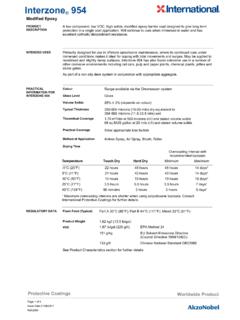Transcription of Beginners Guide to Soxhlet Extractions - Erowid
1 Anabolicminds Archive Beginners Guide TO Soxhlet Extractions PAGE 1 of 4 BEGINNER | Intermediate | Advanced CHEMO Administrator Submitted: April, 2003 SUMMARY The extraction methods present for most solid samples usually involve a substantial amount of wet chemistry. If one were not versed in the chemical arts it is hard to be confident and proactive in heading off experiment failure due to lack of education, experience, or understanding. A viable alternative to the traditional wet methods of solvent extraction is a Soxhlet type of apparatus which allows for near 100% active material recovery and user friendliness.
2 The general In this mini-article we will explore efficient solid-liquid Extractions using a Soxhlet type apparatus and application of theory to utility setups. GENERAL BACKGROUND The simplest form of solid-liquid extraction is the treatment of a solid with a solvent. An example of this would be in separating a sand/salt mixture by using water. Swirl for a few moments and decant, or pour off, the salt (now in the water layer). The sand remains since it is INSOLUBLE. In all solvent Extractions an attempt is made to take advantage of differences in solubility between the species being separated.
3 1. Soxhlet The apparatus, first described in 1879, is a versatile tool that can be used to separate a single gram to hundreds of grams with near 100% recovery. The basic procedure calls for a solid sample to be placed in a porous container and allowing condensed solvent to extract continuously. The figure on the right shows the basic components of a Soxhlet apparatus: Condenser Function is to cool the solvent vapor and cause it to condense (turn back into a liquid). Figure shows a ring type of condenser which functions by increasing the surface area that can be used to transfer heat.
4 This is very similar to a heat exchanger or automotive radiator that is used to dump excess heat. Porous Container Function is to hold the solid sample and allow for the condensed solvent to saturate and pass through thereby extracting active material. This can be likened to a filter in that it retains the insoluble components and allows whatever is dissolved to pass. Distilling Pot Function is to hold the solvent pool and serve as a reservoir for the concentrated material. FIGURE Typical Setup Anabolicminds Archive Beginners Guide TO Soxhlet Extractions PAGE 2 of 4 BEGINNER | Intermediate | Advanced 2.
5 Basic Operation The solvent vapor, generated by gently heating the reservoir, condenses and is allowed to drip back onto the porous sample cup. The liquid condensate that drips onto the sample performs the extraction which then passes through the container and back into the reservoir. The cycle is repeated continuously and can be sustained as long as needed. As it progresses the species of interest is concentrated in the reservoir. In a reverse extraction the species being eliminated may be concentrated in the reservoir instead.
6 An example of this may be to use water as the solvent with a methylcellulose based matrix to be extracted. In this scenario the methylcellulose would be collected in the reservoir and the active species retained in the porous sample cup. As elimination of solvent may be a concern for some this method only uses water to perform the extraction and is easily pushed off during common drying procedures. Rate of reflux is especially important here as low vapor pressure solvents such as acetone or methanol may condense faster than the pass-through rate.
7 This will cause the level of solvent in the porous sample cup to accumulate and eventually spill over the side possibly taking material with it. FIGURE Utility Setup 3. Utility Application The condenser can simply be an inverted lid that is filled with a sufficient amount of ice. This will efficiently condense the solvent vapor and also allow for a central drip point. The sample cup can be most any container that is porous, or made to be so, and has sufficient volume to hold the desired amount of material.
8 The sample cup filter can be regular filter paper that has sufficient pore size and can withstand the solvent being used. As an alternative, a common tea bag that is properly rinsed is very robust for applications requiring less than 5 grams of starting material. In this manner one could employ a Soxtec procedure and decrease extraction time and alleviate spill over. The reservoir can be a regular pot. Ensure the heat source is not flame based if using volatile solvents such as acetone or methanol. Anabolicminds Archive Beginners Guide TO Soxhlet Extractions PAGE 3 of 4 BEGINNER | Intermediate | Advanced SOLVENT EXTRACTION A solvent extraction is any technique that is used to separate or isolate a species from a mixture of compounds or impurities.
9 This method of separation relies on the solubility characteristics of the particular species involved. A rather general statement of solute/solvent solubilities can be stated by like dissolves like. In other words, a specie will dissolve in a solvent that is chemically similar to itself. A common example of this would be water and oil. The degree to which one will distribute itself to the other phase is referred to as its partition coefficient. This coefficient is important to determining the choice of solvents as each will vary for different species.
10 A given specie, when in a binary system of immiscible solvents, will distribute itself according to the following equilibrium: XXsolventsolvent21 It follows then the equilibrium constant be defined by: [][]XXKsolventsolventeq12 It should be noted here that we are using concentration instead of activity coefficients so as to keep the material simple. If equal portions of solvents are used this equation becomes: 12solventsolventK As an example of use, assume that specie TA was extracted from an aqueous and ether solution.







